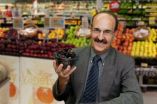(Press-News.org) When it comes to improving bone health in postmenopausal women — and people of all ages, actually — a Florida State University researcher has found a simple, proactive solution to help prevent fractures and osteoporosis: eating dried plums.
"Over my career, I have tested numerous fruits, including figs, dates, strawberries and raisins, and none of them come anywhere close to having the effect on bone density that dried plums, or prunes, have," said Bahram H. Arjmandi, Florida State's Margaret A. Sitton Professor and chairman of the Department of Nutrition, Food and Exercise Sciences (http://www.chs.fsu.edu/nfes/) in the College of Human Sciences. "All fruits and vegetables have a positive effect on nutrition, but in terms of bone health, this particular food is exceptional."
Arjmandi and a group of researchers from Florida State and Oklahoma State University tested two groups of postmenopausal women. Over a 12-month period, the first group, consisting of 55 women, was instructed to consume 100 grams of dried plums (about 10 prunes) each day, while the second — a comparative control group of 45 women — was told to consume 100 grams of dried apples. All of the study's participants also received daily doses of calcium (500 milligrams) and vitamin D (400 international units).
The group that consumed dried plums had significantly higher bone mineral density in the ulna (one of two long bones in the forearm) and spine, in comparison with the group that ate dried apples. This, according to Arjmandi, was due in part to the ability of dried plums to suppress the rate of bone resorption, or the breakdown of bone, which tends to exceed the rate of new bone growth as people age.
The group's research, "Comparative Effects of Dried Plum and Dried Apple on Bone in Post Menopausal Women (http://journals.cambridge.org/action/displayFulltext?type=6&fid=8280928&jid=&volumeId=&issueId=&aid=8280927&fulltextType=RA&fileId=S000711451100119X#top)," was published in the British Journal of Nutrition (http://journals.cambridge.org/action/displayJournal?jid=BJN). Arjmandi conducted the research with his graduate students Shirin Hooshmand, Sheau C. Chai and Raz L. Saadat of the College of Human Sciences; Dr. Kenneth Brummel-Smith, Florida State's Charlotte Edwards Maguire Professor and chairman of the Department of Geriatrics in the College of Medicine; and Oklahoma State University statistics Professor Mark E. Payton.
In the United States, about 8 million women have osteoporosis because of the sudden cessation of ovarian hormone production at the onset of menopause. What's more, about 2 million men also have osteoporosis.
"In the first five to seven postmenopausal years, women are at risk of losing bone at a rate of 3 to 5 percent per year," Arjmandi said. "However, osteoporosis is not exclusive to women and, indeed, around the age of 65, men start losing bone with the same rapidity as women."
Arjmandi encourages people who are interested in maintaining or improving their bone health to take note of the extraordinarily positive effect that dried plums have on bone density.
"Don't wait until you get a fracture or you are diagnosed with osteoporosis and have to have prescribed medicine," Arjmandi said. "Do something meaningful and practical beforehand. People could start eating two to three dried plums per day and increase gradually to perhaps six to 10 per day. Prunes can be eaten in all forms and can be included in a variety of recipes."
INFORMATION:
The U.S. Department of Agriculture funded Arjmandi's research. The California Dried Plum Board provided the dried plums for the study, as well as some funding to measure markers of oxidative stress.
No bones about it: Eating dried plums helps prevent fractures and osteoporosis
2011-08-19
ELSE PRESS RELEASES FROM THIS DATE:
Study finds majority of pharmaceutical ads do not adhere to FDA guidelines
2011-08-19
A study led by Mount Sinai School of Medicine researchers of 192 pharmaceutical advertisements in biomedical journals found that only 18 percent were compliant with Food and Drug Administration (FDA) guidelines, and over half failed to quantify serious risks including death. The study, is published online today in the journal Public Library of Science (PLoS) One.
"Marketing research has consistently shown that journal advertising is the most profitable form of drug marketing, with an estimated return on investment of five dollars for every dollar spent," said Dr. Deborah ...
23andMe replicates over 180 genetic associations with Web-based research platform
2011-08-19
MOUNTAIN VIEW, CA – (August 17, 2011) – 23andMe, Inc., a leading personal genetics company has replicated over 180 genetic associations from a list of associations curated by the National Human Genome Research Institute's Office of Population Genomics ("GWAS Catalog") demonstrating that self-reported medical data is effective and reliable to validate known genetic associations. The results, available online in the journal PLoS ONE establish 23andMe's methodology as a significant research platform in a new era of genetic research.
"In this paper we confirm that self reported ...
B chromosomes affect sex determination in cichlid fishes
2011-08-19
B chromosomes have a functional effect on sex determination in a species of cichlid fishes from Lake Victoria, according to a study by Japanese researchers to be published in open-access journal PLoS Genetics on August 18th, 2011. The researchers found sex-ratio distortions caused by B chromosomes in the breeding line of the cichlids, as well as several protein-coding genes in the B chromosomes. The resultant ratio was female biased, suggesting a role for B chromosomes in female sex determination.
The B chromosome was first identified by E. B. Wilson in 1907. B chromosomes ...
Mutant gene identified that causes abnormal chromosome count, leading to cancer
2011-08-19
Washington, D.C. – Cells with too few or too many chromosomes have long been known to be a hallmark of cancer — but the cause of this abnormal number of chromosomes has been little understood. Now, in the August 19th issue of Science, researchers at the Georgetown Lombardi Comprehensive Cancer Center, a part of Georgetown University Medical Center, have identified a gene that is commonly mutated in human cancers and have demonstrated its direct role in causing aneuploidy, an abnormal number of chromosomes.
The researchers found that 20 percent of the brain cancer (glioblastoma ...
Further, faster, higher: Wildlife responds increasingly rapidly to climate change
2011-08-19
New research by scientists in the Department of Biology at the University of York shows that species have responded to climate change up to three times faster than previously appreciated. These results are published in the latest issue of the leading scientific journal Science.
Faster distribution changes. Species have moved towards the poles (further north in the northern hemisphere, to locations where conditions are cooler) at three times the rate previously accepted in the scientific literature, and they have moved to cooler, higher altitudes at twice the rate previously ...
Annual cervical cancer screening persists, despite recommended guidelines
2011-08-19
Philadelphia, PA, August 18, 2011 – Investigators from the Centers for Disease Control and Prevention (CDC) have determined that the majority of primary care providers continue to recommend annual cervical cancer screening, and less than 15% would extend the screening interval when using the Papanicolaou test and human papillomavirus (HPV) test together, as some guidelines suggest. The results of the study are published online today in the American Journal of Obstetrics & Gynecology (AJOG).
Current cervical cancer screening guidelines, issued by the American Cancer Society ...
Fishing games gone wrong
2011-08-19
VIDEO:
Before they start attaching themselves to kinetochores (green), microtubules nudge chromosomes (red) into position in a "belt " around the center of the spindle.
Click here for more information.
Heidelberg, 19 August 2011 – When an egg cell is being formed, the cellular machinery which separates chromosomes is extremely imprecise at fishing them out of the cell's interior, scientists at the European Molecular Biology Laboratory (EMBL) in Heidelberg, ...
3 waves of evolutionary innovation shaped diversity of vertebrates
2011-08-19
SANTA CRUZ, CA--Over the past 530 million years, the vertebrate lineage branched out from a primitive jawless fish wriggling through Cambrian seas to encompass all the diverse forms of fish, birds, reptiles, amphibians, and mammals. Now researchers combing through the DNA sequences of vertebrate genomes have identified three distinct periods of evolutionary innovation that accompanied this remarkable diversification.
The study, led by scientists at the University of California, Santa Cruz, and published this week in Science, focused on regulatory elements that orchestrate ...
NIH-commissioned study identifies gaps in NIH funding success rates for black researchers
2011-08-19
VIDEO:
The researchers found a 10 percentage point gap in research funding -- even after taking into consideration demographics, education and training, employer characteristics, NIH experience and research productivity. For example,...
Click here for more information.
LAWRENCE, Kan. – Black scientists were significantly less likely than their white counterparts to receive research funding from the National Institutes of Health, according to an analysis of data from 2000 to ...
Gladstone scientist identifies gene that exacerbates risk factors for heart disease and diabetes
2011-08-19
SAN FRANCISCO, CA—August 18, 2011—A scientist at the Gladstone Institutes has discovered how a gene known as SIRT3 contributes to a suite of health problems sweeping across America, offering new insight into how to combat these potentially fatal conditions.
In a paper being published today in Molecular Cell, Gladstone Senior Investigator Eric Verdin, MD, describes how SIRT3, when switched off, accelerates the build-up of fats throughout the body. This can lead to obesity, high blood pressure and a decreased ability to process sugar—the combination of which is known as ...


